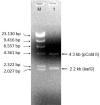Molecular Analysis of katG Encoding Catalase-Peroxidase from Clinical Isolate of Isoniazid-Resistant Mycobacterium tuberculosis
- PMID: 30140323
- PMCID: PMC6101688
Molecular Analysis of katG Encoding Catalase-Peroxidase from Clinical Isolate of Isoniazid-Resistant Mycobacterium tuberculosis
Abstract
Isoniazid (INH) is a drug for the treatment of tuberculosis in patients infected with Mycobacterium tuberculosis. The katG enzyme, or catalase-peroxidase, activates the pro-drug INH that is coded by the katG gene in M. tuberculosis. Mutations of the katG gene in M. tuberculosis are a major INH resistance mechanism. The M. tuberculosis clinical isolate R2 showed INH resistance at a high level of 10 µg/mL. However, the molecular basis for the resistance is unclear. The identification of a mutation in the katG gene of the clinical isolate R2 showed four mutations, i.e., C1061T, G1261 A, G1388T, G2161A, which correspond to the amino acid substitutions T354I, G421S, R463L, and V721M, respectively. The mutant katG gene, along with the wild-type were cloned, expressed and purified. The mutant enzyme showed 86.5% of catalase and 45% of peroxidase activities in comparison to the wild type. The substitutions of T354I and G421S in mutant katG R2 created significant instability in the adduct triad complex (Trp107-Tyr229-Met255), a part of the active site of the catalase-peroxidase enzyme in the model structure analysis. The events could be based on the high resistance of the clinical isolate R2 toward INH as the molecular basis.
Keywords: Mycobacterium tuberculosis; catalase-peroxidase; isoniazid; katG.
Figures








Similar articles
-
Mutation of katG in a clinical isolate of Mycobacterium tuberculosis: effects on catalase-peroxidase for isoniazid activation.Ukr Biochem J. 2016 Sep-Oct;88(5):71-81. doi: 10.15407/ubj88.05.071. Ukr Biochem J. 2016. PMID: 29235814
-
Three-dimensional model and molecular mechanism of Mycobacterium tuberculosis catalase-peroxidase (KatG) and isoniazid-resistant KatG mutants.Microb Drug Resist. 2004 Winter;10(4):269-79. doi: 10.1089/mdr.2004.10.269. Microb Drug Resist. 2004. PMID: 15650370 Free PMC article.
-
Analysis of interactions of clinical mutants of catalase-peroxidase (KatG) responsible for isoniazid resistance in Mycobacterium tuberculosis with derivatives of isoniazid.J Glob Antimicrob Resist. 2017 Dec;11:57-67. doi: 10.1016/j.jgar.2017.06.014. Epub 2017 Jul 23. J Glob Antimicrob Resist. 2017. PMID: 28743650
-
Overview on mechanisms of isoniazid action and resistance in Mycobacterium tuberculosis.Infect Genet Evol. 2016 Nov;45:474-492. doi: 10.1016/j.meegid.2016.09.004. Epub 2016 Sep 6. Infect Genet Evol. 2016. PMID: 27612406 Review.
-
Impact of isoniazid resistance on virulence of global and south Indian clinical isolates of Mycobacterium tuberculosis.Tuberculosis (Edinb). 2014 Dec;94(6):557-63. doi: 10.1016/j.tube.2014.08.011. Epub 2014 Sep 6. Tuberculosis (Edinb). 2014. PMID: 25270728 Review.
Cited by
-
The H2O2 inherently released by the mycobacterial minor subpopulation enhances the survival of the major kin subpopulation against rifampicin.Curr Res Microb Sci. 2022 Jun 18;3:100148. doi: 10.1016/j.crmicr.2022.100148. eCollection 2022. Curr Res Microb Sci. 2022. PMID: 35909613 Free PMC article.
-
Early detection of MDR Mycobacterium tuberculosis mutations in Pakistan.Sci Rep. 2021 Aug 18;11(1):16736. doi: 10.1038/s41598-021-96116-x. Sci Rep. 2021. PMID: 34408186 Free PMC article.
-
Comprehensive genome analysis of Mycobacterium avium subsp. paratuberculosis in camels from Saudi Arabia: Molecular epidemiology and antimicrobial resistance.Vet World. 2025 Apr;18(4):859-876. doi: 10.14202/vetworld.2025.859-876. Epub 2025 Apr 19. Vet World. 2025. PMID: 40453949 Free PMC article.
-
Association Between Diabetes Mellitus-Tuberculosis and the Generation of Drug Resistance.Microorganisms. 2024 Dec 20;12(12):2649. doi: 10.3390/microorganisms12122649. Microorganisms. 2024. PMID: 39770852 Free PMC article. Review.
-
Isoniazid-rhodanine molecular hybrids: design, synthesis, antimycobacterial activity and computational validation.RSC Adv. 2025 Sep 1;15(38):31272-31288. doi: 10.1039/d5ra03641k. eCollection 2025 Aug 29. RSC Adv. 2025. PMID: 40901448 Free PMC article.
References
-
- Anonymous. Tuberculosis. http://www.who.int/tb/areas-of-work/drug-resistant-tb/. Retrieved 2018-02-22.
-
- Purkan Ihsanawati, Natalia D, Syah YM, DS Retnoningrum, HS Kusuma. Mutation of katG in a clinical isolate of Mycobacterium tuberculosis: effects on catalase-peroxidase for isoniazid activation. Ukr Biochem J. 2016;88(5):71–81. - PubMed
-
- Heifets LB. Antimycobacterial drugs. Semin. Respir. Infect. 1994;9:84–103. - PubMed
-
- Zhang Y, Heym B, Allen B, Young D, Cole S. The catalase-peroxidase gene and isoniazid resistance of Mycobacterium tuberculosis. Nature. 1992;358:591–593. - PubMed
-
- Rozwarski DA, Granst GA, Barton DHR, Jacobs WR, Sacchettini JC. Modification of The NADH of The isoniazid Target (InhA) from Mycobacterium tuberculosis. Science. 1998;279:98–102. - PubMed
MeSH terms
Substances
LinkOut - more resources
Full Text Sources
Medical
